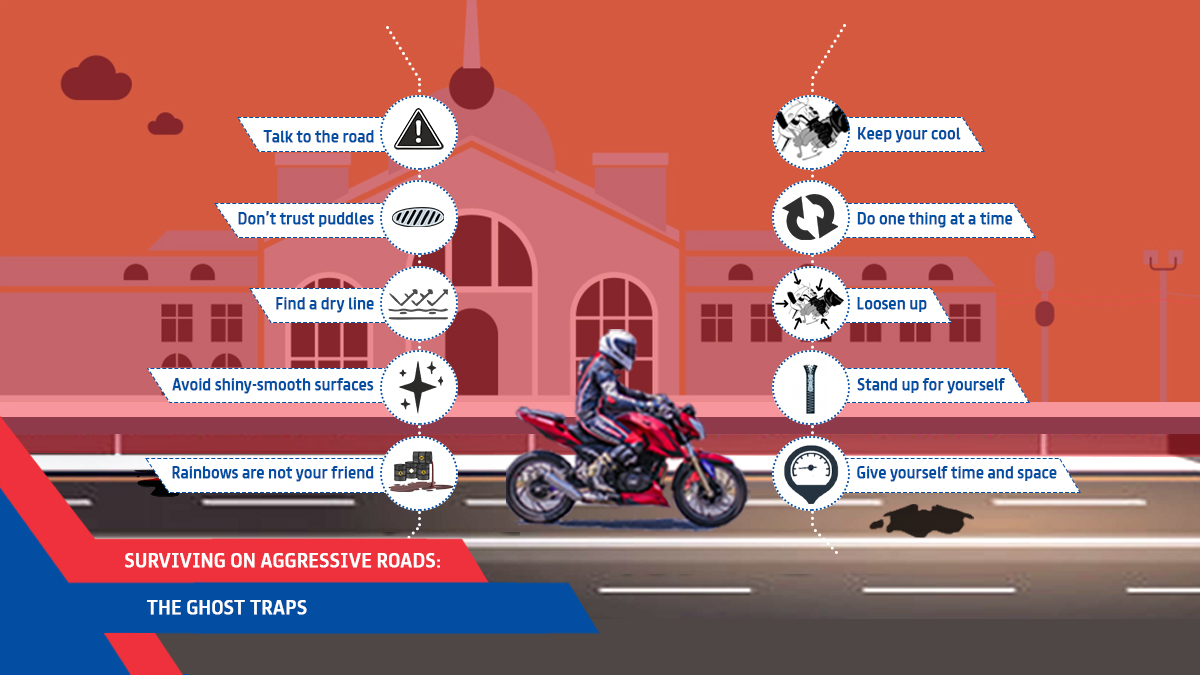While riding a motorcycle on public roads, some factors can be controlled to a certain extent, but some threats extend beyond the rider’s control or expectations. For instance, hazards like potholes, oil or fuel spills, unruly cattle, small animals or sudden change in surface with regards to gravel or water while you are negotiating a corner. How does a rider prepare for and stay safe when encountering such unnerving and unseen elements? The answer is, anticipation.
Anticipating a possible threat at all times while riding means your mind and control points (fingers/feet) are always prepared to execute a last-moment decision and provide rapid inputs in a situation where an unseen threat/obstacle appears out of nowhere. Below are a few basics that will go a long way in keeping you in the saddle and those two wheels on the ground, if and when the road turns against you.
1. Talk to the road -Look for signs which indicate the possible existence of hazards like puddles, off-camber roads, rocks or boulders, uneven patches, gravel, etc. If the route you are riding on is frequented by truck and bus traffic, there is a higher chance of oil/diesel residue on the road. Dial-up your level of alertness to the maximum while riding on such routes. If there are towns through which the route passes, always keep your speed in check and be extra careful while approaching intersections and breaks in the median which facilitate a U-turn.
Never overtake a vehicle from the left as there could be someone driving or riding on the wrong side to avoid a longer detour to get to the other side of the road. Frequent construction activity on Indian roads make diversions pop out of nowhere, without warning. Be careful while tackling such situations as that particular stretch could also turn a dual-carriageway into a non-divided single carriageway where traffic flows both ways.
2. Don’t trust puddles - Innocent-looking puddles can disguise themselves as a foot-deep pothole, or an open manhole. If you can’t avoid riding through one, hold the throttle steady, keep the bike upright, and don’t touch the brakes.
3. Avoid shiny-smooth surfaces - Surfaces that are already slippery on dry days become a skating rink when it rains. Avoid painted lines (over banding on the road), manhole covers, metal plates, and patches of tarmac which had melted during the summer. If you do find yourself caught in one of these, avoid hard braking or acceleration — just ride through without any sudden inputs.
4. Keep your cool - During situations which aren’t ideal, try to stay relaxed and don’t make any sudden moves. Harsh or abrupt acceleration, braking, and steering can quickly eat up your limited traction. Let your inputs be smooth and gentle. If you have to brake hard, do it progressively - slowly squeeze the lever at first to load the front tyre and compress the suspension, then, gradually increase the force until you’ve slowed down enough.
5. Do one thing at a time - While riding in normal conditions, we often combine several actions at once, such as accelerating, shifting gears, or braking while turning. Under tricky conditions, focus on separating these actions (like decelerating to the optimal speed of entry, before turning into a corner). This will reduce the stress on the tyres and allow the rubber to offer optimum traction.
6. Loosen up -. Clinging to the bars with a death grip will do three things which aren’t good: a) Tire you out faster, b) Exaggerate the effects of any movements you make, and c) Keep your bike’s suspension from working as it should. Remember that your bike is designed to handle small bumps and wiggles without upsetting its balance, so allow it to do its job in the most natural manner possible. Grab the handlebar like you are holding something delicate in your palms, keep your shoulders, elbows and core relaxed and use your lower body to steer the motorcycle.
7. Rainbows are not your friend - Those magical, colourful swirls on the road are slippery oil pools which are extremely dangerous. Do not aim for them. They tend to be worse at intersections, where vehicles are stationary for a while and sometimes leak oil. Be extra careful when you’re stopping at or crossing through intersections.
8. Give yourself time and space - Take it easy, especially when it’s raining. Reduce your speed, and maintain a safe distance between yourself and the vehicle in front of you. Braking distances are much longer in the rain, and you can’t count on the bike’s tyres to maintain optimum traction when you need it. Plus, you need time to scan the road ahead and choose your lines, so you can avoid all the aforementioned hazards.
9. Find a dry line - When the heavens open up, whenever possible, try riding in the tyre tracks left by vehicles in front of you. A car’s tyres can act like a plough, displacing water on the road as they roll forward, creating a comparatively drier area until the water moves back into its original place. While taking advantage of this dry line, ensure you always maintain a safe distance from the vehicle ahead. Ensure that the spray from the tyres of the vehicle ahead does not hamper your visibility.
10. Stand up for yourself - While riding during heavy rains, water will often pool in your lap, and if left for too long, it could seep past the zipper. It is not a bad idea to stand up on the pegs every now and then, to clear the accumulation of water from your lap. Anything that takes away your focus from the road will jeopardise yours and others’ safety.



Spare parts